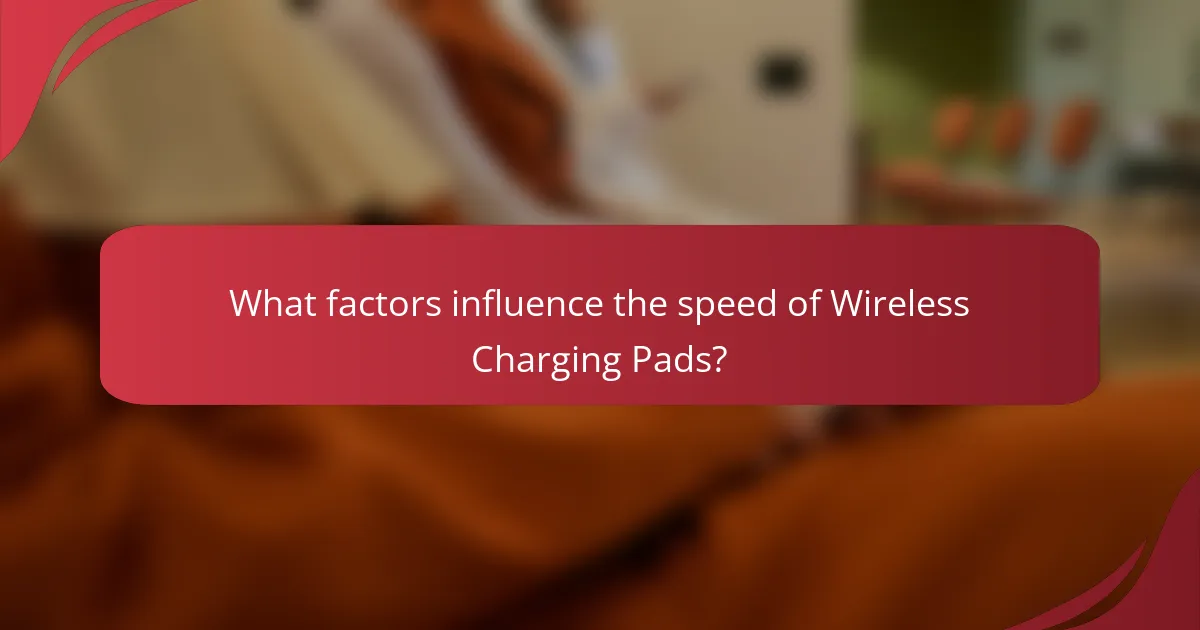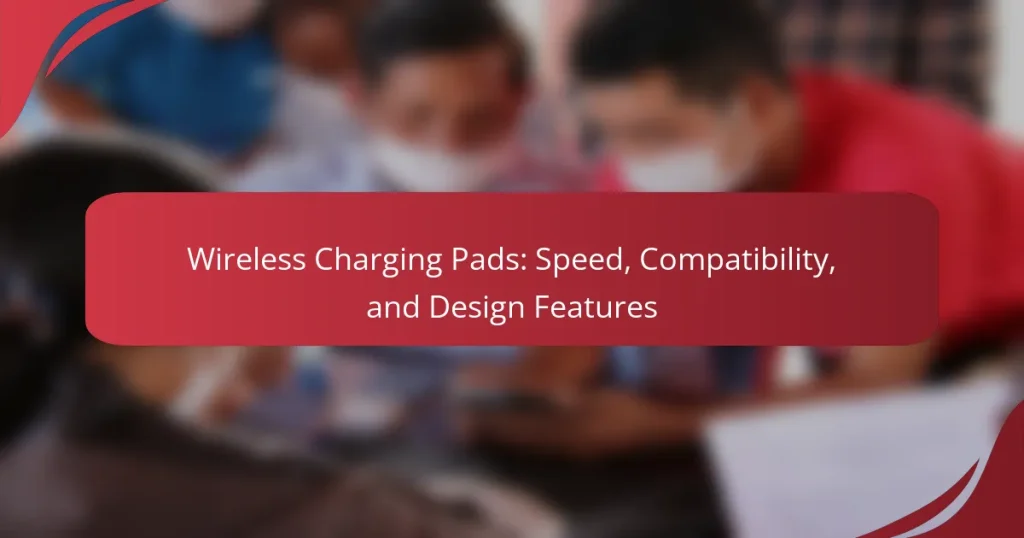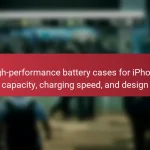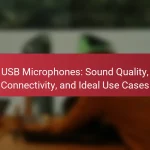Wireless charging pads are devices that facilitate the transfer of power to compatible electronics without the need for physical connectors, primarily using inductive charging technology. This article explores the key features of wireless charging pads, including their speed, compatibility with various devices, and design variations. Factors influencing charging speed, such as power output, alignment, and battery condition, are discussed alongside the importance of adhering to standards like Qi for optimal functionality. Additionally, the article addresses the challenges consumers face due to multiple charging standards and their impact on device compatibility and charging efficiency.

What are Wireless Charging Pads?
Wireless charging pads are devices that enable wireless power transfer to compatible electronics. They utilize electromagnetic fields to transfer energy from the pad to the device. This technology eliminates the need for physical connectors. Wireless charging pads are commonly used for smartphones, smartwatches, and other gadgets. The process is based on the principle of inductive charging. According to the Wireless Power Consortium, Qi is the most widely adopted standard for wireless charging. Many modern devices support this standard, enhancing compatibility. Wireless charging pads come in various designs and sizes to suit different devices. They offer convenience and reduce wear on charging ports.
How do Wireless Charging Pads function?
Wireless charging pads function by using electromagnetic fields to transfer energy between the pad and the device. The charging pad contains a coil that generates an alternating electromagnetic field when powered. The device being charged also has a coil that receives this energy. When the device is placed on the pad, the electromagnetic field induces an electric current in the device’s coil. This current is then converted into direct current to charge the device’s battery. Wireless charging pads typically adhere to the Qi standard, which ensures compatibility among various devices. According to the Wireless Power Consortium, over 1,000 products support this standard, confirming its widespread adoption.
What technology underlies Wireless Charging Pads?
Wireless charging pads utilize inductive charging technology. This technology involves two coils: a transmitter coil in the pad and a receiver coil in the device. When the pad is powered, it generates an electromagnetic field. The receiver coil captures this field and converts it back into electrical energy. This process enables the transfer of energy without physical connectors. Inductive charging is widely used in smartphones and other devices. It adheres to the Qi standard, which is recognized globally for compatibility. Studies show that inductive charging can be efficient, with energy transfer rates typically around 70-80%.
How is energy transferred in Wireless Charging Pads?
Energy is transferred in wireless charging pads through electromagnetic induction. The charging pad generates an alternating electromagnetic field using an induction coil. This field induces an electric current in a receiver coil located in the device being charged. The induced current is then converted into direct current (DC) to charge the device’s battery. This method allows for the transfer of energy without physical connectors. Wireless charging typically operates at a frequency of 110-205 kHz. The efficiency of this energy transfer can vary, often ranging from 70% to 80%.
What are the key benefits of using Wireless Charging Pads?
Wireless charging pads offer several key benefits. They provide convenience by eliminating the need for cables. Users can simply place their device on the pad to charge. This reduces wear and tear on charging ports. Wireless charging pads are also compatible with multiple devices. Many smartphones and accessories support Qi wireless charging. This universality simplifies the charging process. Additionally, wireless charging pads often feature design elements that enhance aesthetics. They can fit seamlessly into home or office environments. According to a study by the Wireless Power Consortium, wireless charging technology is becoming increasingly efficient, with some pads supporting fast charging capabilities.
How do Wireless Charging Pads enhance convenience for users?
Wireless charging pads enhance convenience for users by eliminating the need for cables. Users can simply place their devices on the pad for charging. This design minimizes wear and tear on charging ports. Wireless charging pads are compatible with multiple devices, offering versatility. Many models support fast charging, reducing downtime for users. Additionally, they often feature non-slip surfaces, ensuring devices remain in place. The ease of use promotes a clutter-free environment. Overall, wireless charging pads streamline the charging process significantly.
What safety features are included in Wireless Charging Pads?
Wireless charging pads include several safety features. Common features are overcurrent protection, which prevents excessive current flow. They also have overvoltage protection to guard against voltage spikes. Foreign object detection is another key feature; it identifies and disables charging if metal objects are present. Additionally, many pads include temperature control to prevent overheating during use. These features ensure safe operation and protect both the device and the charging pad.

What factors influence the speed of Wireless Charging Pads?
The speed of wireless charging pads is influenced by several key factors. These include the power output of the charger, which is typically measured in watts. Higher wattage allows for faster charging. The alignment between the device and the charging pad also affects speed. Proper alignment ensures optimal energy transfer. Additionally, the device’s compatibility with fast charging standards plays a significant role. Devices that support protocols like Qi or PMA can charge faster. The material of the charging pad can impact efficiency as well. Certain materials can reduce energy loss during charging. Lastly, the battery condition of the device being charged can influence speed. A battery in poor condition may charge more slowly.
How does the wattage affect charging speed?
Wattage directly affects charging speed. Higher wattage allows for faster energy transfer to devices. For example, a 10-watt charger can charge a device quicker than a 5-watt charger. This is because wattage is a measure of power, calculated as voltage multiplied by current. Increased power results in shorter charging times. Studies show that devices can charge up to 50% faster with higher wattage chargers. Therefore, using a higher wattage charger can significantly enhance charging efficiency.
What are the differences between fast charging and standard charging?
Fast charging delivers power at a higher rate than standard charging. Standard charging typically uses 5W to 10W power output. In contrast, fast charging can range from 15W to 100W or more. This increased power output reduces the charging time significantly. For example, a device that takes 3 hours to charge with standard charging may only take 1 hour with fast charging. Fast charging technology often requires compatible devices and chargers. Many smartphones and tablets now support fast charging standards like Quick Charge or USB Power Delivery. These technologies enable faster energy transfer while maintaining safety protocols.
How do device compatibility and battery size impact charging time?
Device compatibility and battery size significantly impact charging time. Compatible devices can utilize optimal charging speeds. For instance, a device designed for fast charging can receive power more quickly than one that is not. Battery size also plays a crucial role. Larger batteries typically require more time to charge fully compared to smaller ones. A smartphone with a 4000 mAh battery may take longer to charge than one with a 2500 mAh battery. Additionally, the charging pad’s output power must match the device’s requirements for efficient charging. If the charging pad provides insufficient power, charging time will increase. Therefore, both compatibility and battery size are essential factors influencing how quickly a device can charge.
What role does the charging pad’s design play in performance?
The design of a charging pad significantly influences its performance. A well-structured design ensures optimal alignment between the device and the charging pad. This alignment is crucial for efficient energy transfer. Materials used in the pad can affect heat dissipation. Better heat management enhances charging speed and prolongs device battery life. Additionally, an ergonomic design can improve user experience. Pads with non-slip surfaces prevent devices from misaligning during charging. Overall, thoughtful design enhances both efficiency and user satisfaction in wireless charging.
How does the surface material affect charging efficiency?
The surface material of a wireless charging pad significantly affects charging efficiency. Different materials have varying levels of conductivity and heat dissipation. For instance, materials like glass or certain plastics can hinder energy transfer more than metals. Metal surfaces typically allow for better electromagnetic induction, which enhances charging speed. Additionally, surface texture influences alignment and contact area, impacting energy transfer. Research shows that smoother surfaces can improve efficiency by facilitating better contact with the device. In contrast, rough surfaces may lead to energy loss through increased air gaps. Overall, the choice of surface material directly correlates with the effectiveness of wireless charging.
What design features contribute to better heat dissipation?
Design features that contribute to better heat dissipation include materials with high thermal conductivity, such as aluminum or copper. These materials efficiently transfer heat away from the charging pad. Additionally, the incorporation of ventilation holes or fins enhances airflow, allowing heat to escape more effectively. A larger surface area also aids in heat dissipation by providing more contact with cooler air. Furthermore, the use of thermal paste or pads can improve contact between components, facilitating better heat transfer. Studies show that these design elements significantly reduce temperature buildup during charging, improving overall performance and longevity of the device.

How do compatibility and standards affect Wireless Charging Pads?
Compatibility and standards significantly impact wireless charging pads. These elements determine which devices can be charged and how efficiently. Wireless charging pads adhere to specific protocols, such as Qi, which is the most widely used standard. Devices that are Qi-compatible can charge on any Qi-certified pad, ensuring universal functionality.
Incompatibility can lead to slower charging speeds or complete failure to charge. For instance, non-Qi devices may not respond at all when placed on a Qi pad. Additionally, the power output varies among standards, affecting charging times. For example, Qi pads can deliver between 5W to 15W, depending on the device’s compatibility.
The presence of multiple standards can create confusion for consumers. Products that support only proprietary standards may limit user options, reducing market accessibility. Overall, compatibility and standards are crucial for ensuring that wireless charging pads function effectively across a range of devices.
What are the different wireless charging standards available?
The different wireless charging standards available include Qi, PMA, and A4WP. Qi is the most widely adopted standard, developed by the Wireless Power Consortium. It supports power levels up to 15 watts for fast charging. PMA, or Power Matters Alliance, is another standard but is less common. A4WP, or Alliance for Wireless Power, focuses on resonant charging technology. Each standard has unique features and compatibility requirements. Qi remains dominant in consumer electronics, with many devices supporting it.
How does Qi certification ensure compatibility?
Qi certification ensures compatibility by establishing a universal standard for wireless charging. This standard specifies the technical requirements for devices and chargers to communicate effectively. Products that meet these requirements are tested and certified, ensuring they can work together seamlessly. Qi certification includes specifications for power transfer, communication protocols, and safety measures. By adhering to these guidelines, manufacturers create devices that can charge across different brands and models. This compatibility is crucial for consumer convenience and trust. According to the Wireless Power Consortium, over 1,000 products have received Qi certification, highlighting its widespread adoption.
What devices are typically compatible with Wireless Charging Pads?
Smartphones, smartwatches, and wireless earbuds are typically compatible with wireless charging pads. Most modern smartphones from brands like Apple and Samsung support wireless charging. Devices such as the iPhone 8 and newer models utilize Qi wireless charging technology. Android devices, including Samsung Galaxy S series and Google Pixel models, also support this feature. Many smartwatches, like the Apple Watch and Samsung Galaxy Watch, can charge wirelessly. Additionally, wireless earbuds from brands like Apple AirPods and Samsung Galaxy Buds are compatible. These devices are designed to work with Qi-certified charging pads, which are widely available.
What should consumers consider when choosing a Wireless Charging Pad?
Consumers should consider charging speed, compatibility, and design features when choosing a wireless charging pad. Charging speed is crucial as it determines how quickly devices can recharge. Many wireless charging pads offer different wattages, with higher wattages providing faster charging. Compatibility is essential to ensure that the charging pad works with the specific devices consumers own. Most pads support Qi standard devices, but checking compatibility with brand-specific models is advisable. Design features include the pad’s size, material, and whether it has non-slip surfaces or LED indicators. These features affect usability and aesthetics. Additionally, consumers should consider safety features like overcharge protection and heat management to prevent damage to devices.
How can users determine the best charging speed for their needs?
Users can determine the best charging speed for their needs by assessing their device’s specifications. Each device has a maximum supported charging speed, often listed in watts (W). Users should check the manufacturer’s guidelines for optimal charging rates. Additionally, users can consider their usage patterns. For example, if they frequently need quick top-ups, higher wattage chargers may be preferable. Users should also evaluate the charging pad’s compatibility with their device. Some pads support fast charging while others do not. Finally, users can look for reviews and comparisons of charging speeds from credible sources. This information helps in making an informed decision about the best charging speed for individual requirements.
What design features should be prioritized for personal use?
For personal use, wireless charging pads should prioritize compactness, portability, and aesthetic appeal. Compactness ensures the pad fits easily in various spaces, such as desks or nightstands. Portability allows users to carry the pad conveniently while traveling. Aesthetic appeal enhances the overall look of personal environments. Additionally, non-slip surfaces are crucial for stability during charging. These features contribute to a better user experience and satisfaction.
What are the best practices for using Wireless Charging Pads?
Place the device correctly on the charging pad. Ensure alignment with the charging coil for optimal energy transfer. Remove any cases or accessories that may interfere with charging. Maintain a clean surface on both the pad and the device. Avoid using the device while charging to prevent overheating. Use a compatible charger that meets the pad’s specifications. Keep the charging pad in a well-ventilated area. Regularly check for software updates to enhance charging performance.
Wireless charging pads are devices that facilitate the transfer of power to compatible electronics without physical connectors, primarily using inductive charging technology. This article covers the functionality, benefits, and design features of wireless charging pads, highlighting their convenience, safety features, and the impact of compatibility and standards on charging speed. Key factors influencing charging efficiency, such as wattage, surface materials, and device alignment, are explored, along with best practices for optimal use. Additionally, the article discusses various wireless charging standards, particularly the Qi standard, and factors consumers should consider when selecting a charging pad to ensure effective performance.


